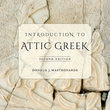 Accentuation Tutorial
Accentuation Tutorial

|
TOPICS Accent and Accent-Marking in Ancient Greek The Last 3 Syllables and the Accents Persistent Accentuation |
Although scholars can deduce how the tonal accent worked on single words and short phrases that were treated as a unit, there is no way to discover how the accents sounded in longer utterances. One approach to pronunciation by a modern student of the language is to ignore the accent. But for mnemonic purposes it is more practical and helpful to give a slight stress to the accented syllable (this practice will also be useful if you later learn Modern Greek). In writing and reading, accents should be used and attended to. Although some accents are not of crucial importance for understanding, there are also many that prevent ambiguities (as the following examples show), and the accents do mirror real facts about the ancient language that linguists can parallel in other languages.
|
||||||||||||||